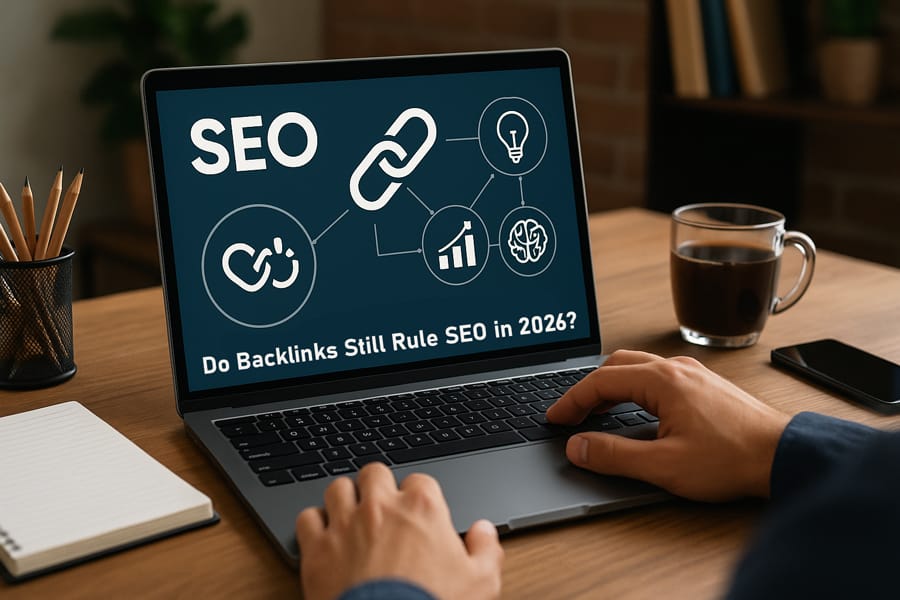Table of Contents
Do Backlinks Still Rule SEO in 2026? Unpacking Their Role in the AI Era
In the early days of search engines, links were the undisputed kings of SEO. A link from one website to another was essentially a “vote of confidence,” signaling authority and relevance. Fast-forward to 2026, and the digital landscape has been transformed. We’re living in an era dominated by AI-driven algorithms, sophisticated natural language processing, and an ever-increasing emphasis on user experience.
This shift has left many wondering: How important are backlinks for SEO in 2026? 🤔 Are they still a foundational ranking factor, or have they become an outdated tactic, overshadowed by smarter algorithms that can discern content quality and intent without relying on external endorsements?
Let’s delve into this pivotal question, examining Google’s evolving stance, analyzing recent empirical evidence, and exploring the role of backlinks as AI continues to redefine search.
1. Backlinks and SEO: Navigating the Confusion in Today’s Landscape
The debate around backlink importance isn’t new. For years, Google has advised against manipulative link-building tactics, promoting a narrative that links should be “natural” and “earned.” This has often led to a misunderstanding that links are less important, or even irrelevant. However, the reality is far more nuanced.
1.1. The Historical Context: PageRank’s Legacy
Google’s original algorithm, PageRank, was revolutionary precisely because it leveraged the concept of backlinks. It treated links as votes, with links from more authoritative pages carrying greater weight. This establishes links as a fundamental signal for authority and relevance.
While PageRank has evolved dramatically and is no longer the sole determinant, the core principle—that external endorsements (links) indicate trust and value—has largely persisted.
1.2. The Shifting Sands of “Importance”
The confusion stems from a few factors:
Google’s messaging: Often simplified to discourage spam.
Algorithm complexity: Google uses hundreds of ranking signals; links are one of many.
Rise of other factors: User experience, content quality, and technical SEO have gained prominence.
AI’s role: The question of whether AI can bypass links to understand content quality is a compelling one.
Despite these shifts, most SEO professionals and empirical studies consistently affirm the continued significance of backlinks. The nature of important links has changed, but their existence remains critical.
2. Google’s Statements and Algorithm Updates: Reading Between the Lines
Google’s representatives often try to guide webmasters away from manipulative link-building practices by downplaying the singular importance of links. However, their core documentation and indirect statements paint a clearer picture.
2.1. Direct Quotes and Official Guidelines
Gary Illyes (Google Analyst): Has stated that links are important but perhaps “overestimated” by many, and that “we need very few links to rank pages.” This is often misconstrued. He’s not saying links are unimportant, but rather that the sheer volume of low-quality links is less effective, and quality trumps quantity.
Andrey Lipattsev (former Google Search Quality Senior Strategist): Famously confirmed that links were one of the top three ranking factors, alongside content and RankBrain (or now, broader AI/machine learning signals). While this was years ago, the foundational principle holds.
Google’s Search Quality Rater Guidelines (E-E-A-T): Emphasize Experience, Expertise, Authoritativeness, and Trustworthiness. How do search engines primarily assess Authority and Trustworthiness? Through the endorsements of other credible sources, which often manifest as backlinks.
Google’s Link Schemes Document: This is perhaps the most telling. Google explicitly lists practices that are “against our guidelines,” confirming that they actively combat certain types of links because they do influence rankings, albeit in a manipulative way. If links had no impact, there would be no need for these guidelines.
Key Takeaway: Google wants to see natural, editorial links. They’re battling unnatural links, not the concept of links themselves.
2.2. Recent Algorithm Updates and Link Signals
Google’s continuous updates, including core updates and specific spam updates (like the March 2024 Spam Update), often target low-quality, manipulative links.
Focus on Relevance and Quality: Updates increasingly devalue links from irrelevant or spammy sources. A link from a highly relevant, authoritative site within your niche is worth exponentially more than hundreds of low-quality, directory-style links.
Contextual Relevance: The context surrounding a link matters more than ever. A link embedded naturally within highly relevant content is more valuable than a link in a blog comment or a footer.
Detection of Link Schemes: Google’s AI has become incredibly sophisticated at identifying patterns indicative of manipulative link-building. This includes Private Blog Networks (PBNs), excessive guest posting on low-quality sites, and widespread exact-match anchor text spam.
3. Empirical Evidence and Studies: What the Data Tells Us
While Google’s statements can be open to interpretation, empirical studies conducted by leading SEO tools and independent researchers offer concrete data. Even in 2025, these studies consistently highlight the strong correlation between backlinks and higher search rankings.
3.1. Study 1: Ahrefs Backlink Statistics and Findings
Ahrefs, with its colossal backlink index (trillions of links), consistently publishes data supporting the correlation between backlinks and search performance.
Referring Domains vs. Keywords: Their studies frequently show a strong positive correlation between the number of referring domains (unique websites linking to a page) and higher search rankings and organic traffic. This suggests diversity of linking sources is highly valued.
Top-Ranking Pages and Link Growth: Ahrefs data indicates that top-ranking pages tend to acquire more new followed links each month compared to lower-ranking pages. While correlation doesn’t always equal causation (high-ranking pages are naturally more visible and earn more links), it underscores that links are a characteristic of successful pages.
Quality over Quantity: Ahrefs tools emphasize Domain Rating (DR) and URL Rating (UR) as indicators of link quality, demonstrating that a few high-DR links are significantly more impactful than many low-DR links.
3.2. Study 2: Backlinko Search Ranking Findings
Brian Dean’s Backlinko, known for its in-depth SEO studies, has consistently found links to be a primary ranking factor.
Average Backlinks for #1 Spot: Their analyses (updated periodically) show that pages ranking in the #1 position in Google typically have significantly more backlinks than pages in positions #2-#10. For instance, a past study found the #1 result had an average of 3.8x more backlinks.
Number of Referring Domains: Similar to Ahrefs, Backlinko’s research also highlights the importance of the number of unique referring domains, not just the total count of backlinks.
Link Velocity: While not explicitly a “ranking factor,” a steady, natural increase in high-quality backlinks (link velocity) is often observed on high-ranking pages, signaling ongoing relevance and authority to Google.
3.3. Study 3: MonsterInsights Ranking Factor Findings (WordPress Perspective)
MonsterInsights, a prominent Google Analytics plugin for WordPress, also conducts research on ranking factors, often tailored to the practical needs of website owners.
“Huge Influence”: Their findings consistently indicate that backlinks “have a huge influence on Google’s ranking algorithm.”
High-Authority Websites: They conclude that “sites with higher quality backlinks usually achieve higher Google ranking positions.” This reinforces the message that links from authoritative, trustworthy websites are paramount.
Trust Signal: MonsterInsights emphasizes that acquiring high-quality links sends a strong signal to Google that your content is trustworthy, as other reputable websites are essentially “vouching” for it.
3.4. Making Sense of Link Data and Associated Claims
It’s crucial to interpret these studies correctly:
Correlation vs. Causation: While a strong correlation exists, it’s not always pure causation. High-quality content naturally attracts links, and ranking well also increases visibility, leading to more links. However, it’s a virtuous cycle where links contribute to higher rankings.
The “Quality” Imperative: All studies universally point to quality over quantity. A single, relevant, authoritative backlink is exponentially more valuable than hundreds of spammy, irrelevant ones.
Holistic SEO: Backlinks are one piece of a complex puzzle. Exceptional content, strong technical SEO, and great user experience amplify the power of good backlinks. Without these other elements, even excellent links may not be enough.
4. What About AI Systems and Large Language Models (LLMs)?
The rise of AI-driven search, particularly Google’s AI Overviews (formerly SGE), introduces a new layer to the backlink debate. If AI can directly understand content quality, intent, and relevance, do links become less important?
4.1. How AI Overviews Work (and How They Don’t)
AI Overviews, powered by LLMs, synthesize information from various web sources to provide direct answers on the SERP. This has led to concerns about “zero-click searches” and reduced organic traffic.
Information Synthesis: LLMs are excellent at understanding language, summarizing, and generating text. They can grasp nuances in content that traditional algorithms might struggle with.
Still Relies on Indexed Web: Crucially, AI Overviews still pull information from Google’s index of the web. This index is built through crawling and understanding web pages, where links play a vital role.
Authority and Trust for AI: For an AI to confidently synthesize and present information, it still needs to assess the credibility and authority of the sources it’s drawing from. How does it do this? By relying on established signals of authority, which include, prominently, backlinks. If a site is well-linked by other reputable sites, the AI is more likely to trust its information.
E-E-A-T for AI: The E-E-A-T framework (Experience, Expertise, Authoritativeness, Trustworthiness) is more critical than ever. Backlinks (especially from highly authoritative sources) are a primary signal of Authoritativeness and Trustworthiness for both traditional algorithms and AI systems.
4.2. The Nuanced Relationship: Links as Trust Signals for AI
Think of it this way: AI can read and understand content. But it still needs help determining which content is the most reliable, accurate, and authoritative to present to users. Backlinks serve as a powerful signal for this.
Fact-Checking by Proxy: If multiple reputable sources link to a piece of information, it acts as a form of “collective fact-checking” that AI can leverage.
Reputation Building: Backlinks help build the overall reputation of a domain. AI systems are designed to prioritize information from established, reputable entities. A strong backlink profile is a cornerstone of that reputation.
Discovery and Prioritization: Backlinks still play a role in helping Google’s crawlers discover new content and understand its relative importance within the vast web. AI cannot process information it hasn’t found or deemed worthy of deep analysis.
Conclusion: While AI improves content understanding, it doesn’t replace the need for authority signals. Backlinks, particularly high-quality ones, continue to be a fundamental trust and authority signal that AI systems will utilize to identify reliable sources.
5. Understanding the Role of Backlinks in 2026: A Modern Perspective
In 2026, backlinks are not just “important”; they are a critical, foundational pillar of a comprehensive SEO strategy, especially when understood in the context of quality, relevance, and the AI-driven future.
5.1. Backlinks as Votes of Confidence and Authority
Still the “Currency of the Web”: Links are still how authority and relevance flow across the internet. They signal to search engines that your content is valuable enough for others to reference.
Domain Authority and Page Authority: While these are third-party metrics (Ahrefs DR, Moz DA), they reflect the underlying concept of link equity and remain correlated with Google rankings. Building a strong link profile directly contributes to these metrics.
Trust and Credibility: In an age of misinformation and AI-generated content, trust is paramount. High-quality backlinks from reputable sources are powerful indicators of credibility for both users and search engines.
5.2. Beyond Ranking: Other Benefits of Backlinks
While ranking is the primary SEO goal, backlinks offer additional, often overlooked, benefits:
Referral Traffic: A link from a popular, relevant website can send direct, qualified traffic to your site. This traffic is often highly engaged and can lead to conversions.
Brand Exposure and Awareness: Links from prominent publications or industry leaders increase your brand’s visibility and build its reputation.
Networking Opportunities: The process of earning backlinks naturally leads to building relationships with other webmasters, publishers, and influencers in your niche.
Faster Indexing: Links from already-indexed pages can help search engines discover and index your new content more quickly.
5.3. The Evolution of Link Building: Quality, Relevance, and Intent
The emphasis has shifted from “link building” (a mechanical process) to “link earning” or “relationship building.”
| Outdated Link Building (Avoid) | Modern Link Earning (Focus) |
| Quantity over quality (1000 low-quality links) | Quality over quantity (1 relevant, high-authority link) |
| Exact-match anchor text stuffing | Natural, varied anchor text (branded, naked URL, partial match) |
| Spammy directories, comment spam | Editorial placements, digital PR, resource pages |
| Buying links without disclosure | Earning links through exceptional content |
| Private Blog Networks (PBNs) | Genuine outreach, relationship building |
| Irrelevant links | Highly relevant, contextual links |
How to Earn High-Quality Backlinks in 2026:
Create “Linkable Assets” ✨:
Original Research & Data: Studies, surveys, industry reports that others will cite.
In-Depth Guides & Tutorials: Comprehensive resources that become the go-to source for a topic.
Unique Tools & Calculators: Interactive content that provides value.
Engaging Infographics & Visualizations: Complex data made easy to digest and share.
Strategic Content Promotion 📣:
Digital PR: Leverage your brand’s story and expertise to get mentions and links from news outlets and industry publications.
Guest Posting (Quality-Focused): Write genuinely valuable articles for highly relevant, authoritative sites in your niche. Focus on providing value to their audience.
Broken Link Building: Find broken links on reputable sites and offer your relevant content as a replacement.
Resource Page Outreach: Identify resource pages in your niche and suggest your content as a valuable addition.
Relationship Building🤝:
Connect with journalists, bloggers, and influencers in your industry. Genuine relationships often lead to natural mentions and links.
Internal Linking Optimization 🔗:
While not backlinks, strong internal linking signals important pages to Google and passes authority throughout your site, amplifying the effect of external links.
6. Conclusion: Backlinks Remain a Cornerstone of SEO in the AI Era
The short answer to “How important are backlinks for SEO in 2026?” is: Extremely important, but with an ever-increasing emphasis on quality, relevance, and natural acquisition.
The advent of AI Overviews and more sophisticated algorithms doesn’t diminish the role of backlinks; it refines it. AI systems still need strong signals of authority and trust to determine which information to prioritize and synthesize. Backlinks, when earned authentically from reputable sources, continue to be one of the most powerful and enduring signals for this.
Focus on creating truly exceptional content that deserves links. Then, strategically promote that content and build genuine relationships to earn those valuable endorsements. In 2026, a robust, high-quality backlink profile is not just a competitive advantage; it’s a fundamental requirement for achieving scalable search success and building a truly authoritative online presence.
Don’t let the whispers of “links are dead” deter you. Instead, adapt your strategy to the evolved landscape: think quality, think relevance, think E-E-A-T, and think long-term relationship building. Your website’s reign in the SERPs still heavily depends on the votes it receives from the web’s most trusted voices.
Ready to build a powerful backlink profile that truly moves the needle for your website in 2026 and beyond?
At WebSEOWrite.pk, we specialize in cutting-edge SEO strategies that adapt to the latest algorithm shifts and AI advancements. Our team focuses on ethical, high-quality link earning that builds genuine authority and drives sustainable organic growth.
Don’t leave your SEO to outdated tactics!




